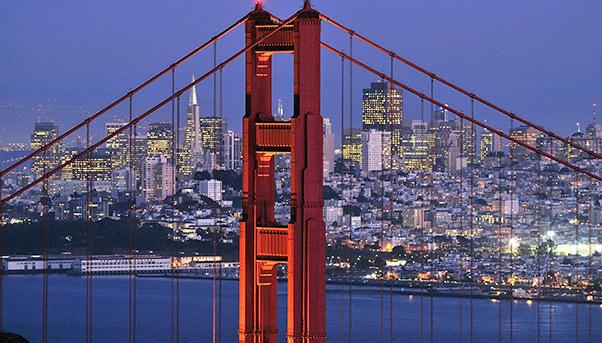Once called “the bridge that couldn’t be built”, it has come to be considered one of the seven wonders of the modern world and a monument loaded with social and cultural meaning.
The Golden Gate Bridge stretches across the San Francisco Bay to link the eponymous city with Marin County to the north in the U.S. state of California. The single-suspension structure is 2.7 kilometres long with a tower at each end rising 230 metres to support two steel cables that stretch for 2.13 kilometres. Designed by Joseph Baermann Strauss, its construction was approved in 1930 by San Francisco voters. The city obtained $35 million from the banks. Although it had to pay interests amounting to $34 million, it was able to do it quickly thanks to the income generated from a user toll placed on the bridge.
Begun in 1933 and completed in 1937, the bridge has a span of 1.28 kilometres, a height of 67 metres above water level and a weight of 420,000 tons. At the time of its construction it was the longest suspended bridge in the world, capable of resisting winds of up to 70 miles per hour as well as earth tremors, among which the terrible Loma Prieta of 1989 that reached 7.1 on the Richter Scale.
Recognized as one of the most significant examples of civil engineering for its structure as well as its esthetics, the Golden Gate Bridge is considered one of the modern marvels by the American Society of Civil Engineers. But its importance goes beyond its value to the engineering world, for it takes its place in recent U.S. history as the scene of social gatherings. During Michelle Obama’s physical fitness campaign, hundreds of people met on the bridge to do jumping jacks to try to set a Guinness World Record for the most people doing the exercise in a 24-hour period. The bridge is also a place for sporting celebrations, like the Nascar championships or the Harlem Globetrotters.

Through the years the bridge has become a point of reference for the San Francisco community and beyond. It attracts tourists and residents even when it is not looking its best and its varnish is a little faded. Indeed, every year 38 workers use 38,000 litres of International Orange paint to give it a fresh coat. Engineering, history, cinema and anecdotes of those who go there to celebrate their 70 years... the bridge is proof of how big infrastructure can be a place for social gatherings. The Golden Gate is the only bridge to which the U.S. Postal Service has dedicated a stamp. It has witnessed scenes in the fight for civil liberties and other causes, sometimes eccentric cases in pure San Francisco style: actor Woody Harrelson and a group of environmentalists once climbed up to the cables to protest in favor of the sequoia trees of California.
So it should not surprise if together with the adjacent Golden Gate Park of more than four square kilometres, the bridge has become one of the main tourist attractions in the United States. Every year it receives 13 million visitors and is a fundamental asset to the economy of California, often described as the sixth economy in the world.


